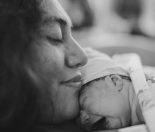This article gives information on Caesarean in Detail – what happens before and after a Caesarean section in New Zealand, what is involved and detail on what it feels like.
For information on why you may need a Caesarean section, the risks and complications and how you can help yourself, see our article on Caesarean Section. An explanation of the terms planned, emergency or crash caesarean are also included in this article.
What follows is an outline of the Caesarean procedure and how it will feel for you.
Caesarean: Pre Op
Firstly a decision has to be made, between yourself and your health professionals (obstetrician, Lead Maternity Carer, midwives, anaesthetist) that this is the best option for you and your baby. The procedure will be explained and you will be asked to sign a consent. This is to verify that you understand the potential risks and complications of surgery and that, in the event of a complication, you are agreeing to further treatment, such as a blood transfusion.
If you have not already had blood taken, this will happen now. Your haemoglobin (iron level), your blood’s ability to form a clot and your blood group will all be checked. Two or three tubes of blood will be filled, via one needle, usually on the inside of your elbow.
As you will need intravenous fluids, a luer (plastic tube) will be inserted into a vein in your hand or arm, which is done using a needle- then the needle is removed and the plastic tube is left in the vein and secured in place with sticky tape. This can be painful, so if you are afraid of needles ask about having a bit of local anaesthetic in your hand first. Once the needle is removed the luer will not hurt, but can feel uncomfortable – it will be removed after your operation, when you are able to eat and drink again.
You will need to give information to the midwives and doctors about when you last ate and drank and any previous medical history you may have – for example previous operations and anaesthetics. You will be asked to change into a loose fitting gown for the operation and to remove contact lenses and all jewellery (a wedding band can be taped over if you do not want to remove it).
At this stage you will have a shave of the top inch of your bikini line, where the scar will be hidden. The midwife will usually do this for you, using an electric razor.
One of the problems of any operation (particularly when you are pregnant) is the period of immobility that follows – like being on a long haul flight – so you will be asked to wear anti-embolic stockings to aid your leg circulation.
Also, because you will not be able to get up to go to the toilet afterwards, a urinary catheter will be inserted into your bladder. This is a thin plastic tube which is gently inserted via your urethra (the passage from your bladder to the outside) and drains all urine from your bladder into a bag. This will usually stay in until the following day, when you will be up and about again.
The Caesarean Section
Source: Regina General Hospital – This video is provided for informational purposes only and may differ from your actual operation
When you go in to the operating theatre, the first thing that may strike you is the large number of people there! This will include:
- The surgeon and the assistant surgeon
- The anaesthetist and the anaesthetic technician
- The scrub nurse and the assistant
- The midwife
- The paediatrician (baby doctor)
- And last but not least, you and your partner!
Firstly you will need an anaesthetic – usually you will stay awake and have a spinal or epidural block so that you are pain free, but awake to greet your baby. But you will still be aware that something is happening – it feels as though someone is ‘washing up’ inside you!
Occasionally you may be advised to have a general anaesthetic, where you are put to sleep. If so, your partner will have to wait outside, as the anaesthetist is too busy concentrating on your well-being to have extra people present.
You will be laying on an operating table, tilted very slightly up – that is, your head will be slightly lower than your pelvis. There will be a cloth screen in front of you, so that you can’t see the surgery, and nor can your partner, if he is staying near you (by your head). This is especially good if either of you are feeling squeamish!
Your skin will be cleaned and draped, to keep the area sterile. The obstetric surgeon will check you are numb and then begin the operation, cutting through the skin, muscle and into the womb, usually taking 5-10 minutes. You may hear suction as the amniotic fluid around baby gushes out.
Your baby will be lifted out by the doctor (occasionally using forceps if it is a tight squeeze) and shown to you over the drapes. After the cord has been cut, the midwife and baby doctor dry, wrap and check your baby over and bring the baby to you and your partner, where you will see and touch your baby for the first time.
Meanwhile the surgeon will deliver your placenta and begin to stitch up the womb, muscle and skin layers – this takes about ½ an hour. A simple dressing will be put over your wound and a sanitary towel placed between your legs, for any vaginal blood loss.
Post Op: After a Caesarean Section
You, your partner and your new baby will be moved to the recovery area after the operation is finished. A nurse or midwife will care for you here and you will be assisted with your baby’s first breast feed. As the anaesthetic block wears off you will need pain relief – usually this is a continuous infusion for the first day, often ‘patient controlled’ so you can boost your pain relief as necessary.
Your urinary catheter and intravenous drip stay in place until you are up and about and eating and drinking again. Initially you will not be able to lift your baby, but midwives will help you with this. After an hour or two in recovery area, you will be transferred to the postnatal ward, where most women stay with their babies for 3-5 days, following a caesarean section. After the first 24 hours you will probably need only oral pain killers and the more you get up and walk about, the quicker your recovery will be.
Your full recovery period will take a minimum of 6 weeks, during which time you will be advised to lift only your baby, do gentle abdominal and leg exercises, eat well and gain plenty of rest. For many women the recovery period takes a lot longer – listen to your body, look after yourself and ask for help, to enable you to be a better, more active mum in the long run!
For more information on Caesarean sections see our article Caesarean Section which covers terminology, indications, and risks and complications.








hi there
Any info please
I am 31 week pregnant and so stressed to go for a natural birth. Is it possible to go for a c section from my choice in NZ without a medical reason? if so how it work? I talk this with my midwife and she said i cant choose unless any medical condition. But am getting really stressed of thinking natural birth as I am a bit scared.
Hi Tara, have you tried this article: https://www.kiwifamilies.co.nz/articles/caesarean-section/ — Jarrod
Hi I’m pregnant with my first child and I’m due in a couple months and I was planning to have a C-section just because I have chronic Anal fissure for a year now (had it before the baby) and it doesn’t seem to be healing. I’ve already had surgery for it and it didn’t work. Now that I’m pregnant the constipation has opened the years back up and my pain after I pass a stool last for 24 hours My reasons for having a planned C-section is because If I was to give birth naturally I’m afraid I could tear.and… Read more »
Hi Aaliyah, you’re definitely not overthinking it! Every pregnancy is different, and everyone’s body is different too. You want your birth to be the least traumatic event possible for the best start for both you and your bubs. This means listening to your own body, following your own intuition, asking lots of questions of the experts, and listening carefully to them of course, but making the right decision for you at the end of the day. Women all around the world choose a c-section for a variety of different reasons, just go with what feels right. — Jarrod
Hi there, I am currently considering starting a family with my partner, and he is always telling me not to worry about the birth side of things but I am absolutely terrified of the idea of it. My mum had a traumatic birth with my older sister and ended up having to have a c-section (which she then had one with the rest of us), my sister has just had the same recently, and my cousin! We are all very similar build (small) and it scares me of going through all the cutting and pain to then have a c-section… Read more »
Hi there, I had a crash c section on March 2nd 2013. I was told before leaving hospital that I could not have a baby for 18 months, which I assumed meant give birth before this time, however are you please able to confirm this is correct, or is it in fact get pregnant before 18 months.
Thank you in advance,
Sophie
Hi, I am currently pregnant with my 3rd child. My first 2 deliveries where horrendous to say the least, both got stuck in the birth canal and both needing assistance to get out as there heart rates were dropping and both of us were distressed. My first was an episiotime (sorry do not know how to spell – the cut) which lead me to not be able to go to the toilet for about 3 days and was very painful for a while after, my second was forceps and that was just plain scary to see how he used them… Read more »
Hi Melissa. Sorry to hear of your traumatic deliveries with your first two children. Without wishing to sound dismissive, although not “normal” what occurred would also likely not rate as extraordinarily unusual, especially if you had an epidural. Episiotomies occur to make it possible to do an instrumental delivery (many of which occur every day in hospitals globally). It is common with spontaneous natural births that women may not go No.2’s for a couple of days afterwards, and 3-days after for an episiotomy is not rare. Perineal discomfort after an episiotomy is normal and should be treated with regular analgesia… Read more »
hi there,
I am a mother of 2 children, aged 5 and 2 yrs. And both were caesarean born, I just wanted to make sure if it is safe to have a third kid again with caesarean? What is the risk?
Thanking you,
Christina
I’m unable to quote specific statistics, but can assure you that many NZ women have three children, all delievered by C-Section. C-Sections are never routine surgery and should always be treated with immense respect as a relatively major operation. However, when a woman has had two previous C-Sections and is expecting again, the Obstetricians definitely would recommend a 3rd C-Section as being safer than attempting a labour with vaginal birth. Thus, because many women have more than two pregnancies (planned or otherwise) Obstetricians do perform 3rd C-Sections, of course. Significant increased surgical risk factors can oftentimes relate more to the… Read more »
.